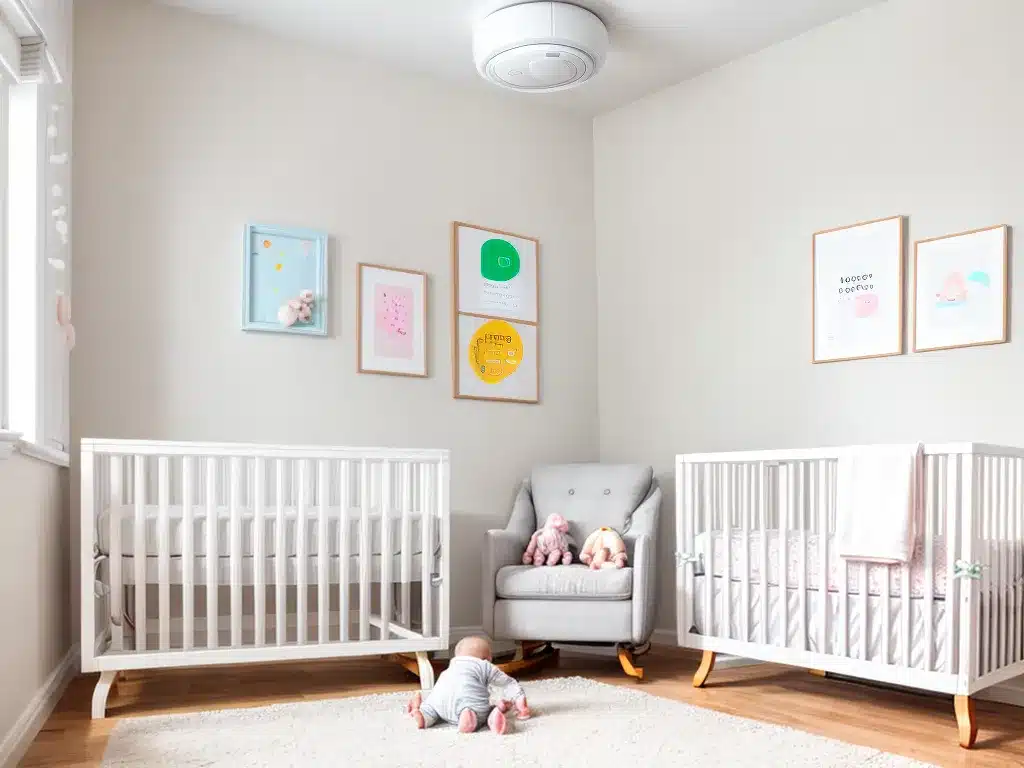Introduction
As a new parent, I want to make sure my baby is safe and comfortable at all times. That’s why I’ve been exploring different smart nursery technologies that can help me monitor my little one, even when I’m not in the room. In this article, I’ll provide an in-depth look at the various smart devices and apps available for remote baby monitoring and analysis.
Baby Monitors
Traditional Audio and Video Monitors
For years, traditional baby monitors have been the go-to gadget for listening in on baby from another room. Most monitors consist of a camera unit placed in the nursery, and a receiver carried by parents throughout the house. The latest versions have clear two-way audio, allowing me to both see and speak to my baby. Some key factors I evaluated when choosing a video monitor were:
- Night vision – Allows seeing baby in dark rooms
- Multiple cameras – View different areas like crib and playpen
- Temperature sensors – Monitor room temperature for baby’s comfort
- Long range – Hear/see baby from anywhere in the house
- Talk back – Communicate through built-in microphone
While these features are useful, I ultimately wanted smart capabilities beyond just video streaming.
Smart Baby Monitors
Going with a smart video monitor instead of a traditional one allows me to analyze and track a range of data to understand patterns and receive actionable insights about my baby. Capabilities I was looking for included:
- Sleep tracking – Logging sleep times and patterns
- Notifications – Alerts for crying, inadequate sleep, etc.
- Activity tracking – Monitor baby movements and milestones
- Vital signs – Measure heart rate, oxygen levels, temperature
- Encrypted data – Ensure video feeds are secure and private
After comparing several options, I selected the Nanit Smart Baby Monitor. Its unique features include computer vision tracking to monitor breathing, customizable sleep goals and coaching, and the ability to replay moments I missed.
Sleep Tracking Apps and Devices
In addition to smart monitors, using dedicated sleep trackers can provide further data about my baby’s slumber patterns. Some options I explored were:
Sleep Tracking Mats
- Place under crib mattress to detect movements
- Track total sleep time, restlessness, and interruptions
- Sensors are thin and don’t affect comfort
- Sync data to apps via Bluetooth or WiFi
After testing the Babysense under mattress movement monitor, I felt the non-wearable aspect made it easy to use without interfering with my baby’s sleep. The associated app provides helpful sleep pattern analysis.
Wearable Sleep Trackers
- Lightweight, designed for baby’s foot or diaper
- Track total sleep time, interruptions, position changes
- Extended battery life and wireless connectivity
- Some track heart rate, oxygen, skin temperature
The Baby Vida Band provides comprehensive data on sleep cycles, heart rate trends, and the exact times baby wakes up. I can even share this biometric data with my pediatrician for informed care.
Sleep Tracking Mobile Apps
- Manually log sleep sessions, naps, and night sleep
- Set nap schedules and bedtimes to establish routine
- Receive alerts for scheduled sleep and wake times
- Analyze patterns over time
Though they lack sensors, sleep logging apps like Baby Tracker provide a helpful way for me to document baby’s sleep visually. I can share my log with family members caring for the baby as well.
Analytics from Smart Devices
Here are some ways smart nursery devices allow me to analyze data and spot trends:
Monitor Sleep Quality
- Check total sleep duration each day/week
- Identify frequent night wakings and restlessness
- Track naps to ensure adequate daytime sleep
- See if schedule changes affect sleep cycles
Log Growth Milestones
- Video analytics detect rolling over, sitting, crawling.
- Help track motor skill development over time
- Identify developmental delays early
Detect Health Issues
- Sudden increases or decreases in heart rate or oxygen levels may indicate illness
- Changes in sleep patterns can signal discomfort, pain, or growth spurts
- Skin temperature shifts can be a sign of fever or room comfort issues
Having tangible data from smart devices gives me peace of mind that my child is safe, healthy, and hitting all their growth milestones.
Conclusion
Smart baby tech has given me invaluable insights into my newborn’s sleep, development, and health. While traditional monitors satisfy the basic need to see and hear baby, innovative analytics from smart sensors and computer vision take it to the next level. I feel empowered making data-driven decisions about my child’s care and routine. As more nursery gadgets come equipped with artificial intelligence, I’m excited to have a helpful partner on this journey of parenting. My advice to new moms and dads is to embrace smart tech to help monitor your baby – the data it provides when used properly can help lead to a happier, healthier child!












